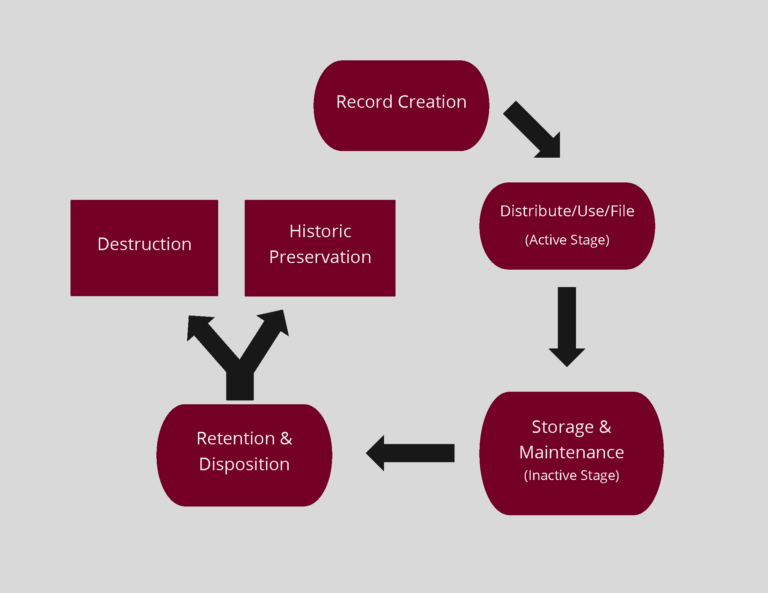
MANAGEMENT OF RECORDS
Records management consists of several fundamental activities that each program must undertake in order to ensure an effective program. Records must be clearly identified, organized into series, and stored in offices using file plans that document the method used to organize the records. Records must be appropriately scheduled, in accordance with Wisconsin state law, with their retention period and disposition clearly noted. The disposal of records must be consistent and systematic and must be conducted legally and in accordance with the appropriate schedules.
Fundamental Activities
- Records Creation
- Records Inventory
- Filing Plans
- Retention Schedules
- Records Storage
- Records Retention & Disposition
- Records Destruction or Historic Preservation
Records Creation
Records are normally created to document a transaction, to support a right or a claim, to explain/implement a policy, to inform clients and users, to protect organizational rights and liability and to provide accountability. In order for records to accomplish these functions, they must:
- Be prepared in the normal course of business
- Have an independent business purpose.
- Be complete, accurate and reliable.
- Be created with no motive to misrepresent or commit fraud.
- Be prepared without foreseeing litigation.
- Be factual.
- Be authentic.
In order to be complete, accurate, reliable, and authentic, records must have content, context, and structure. These concepts are critical to the creation and understanding of any record, but are particularly necessary to the understanding of digital records.
- Content means: the intellectual substance of a document including text, data, symbols, numerals, images, and sound.
- Context means: the organizational, functional or operational circumstances surrounding the materials creation, receipt, storage, or use, and its relationship to other materials. Context is information that will assist the user in understanding the content.
- Structure means: the manner in which elements are organized, interrelated, and displayed. This can be the original way that the information was made and reproduced on a screen. It reflects the logical hierarchy of and the relationship between the parts of the record.
Information Analysis:
Information analysis, also referred to as records appraisal, is the determination of the value of the content of a given record. Multiple parties are involved in appraising records: the creating office, campus legal counsel and internal auditors; and the campus records officer.
Generally, information analysis encompasses consideration of the following values:
- Administrative Value: The usefulness or significance of records to support ancillary operations and the routine management of an organization. Records having administrative value are generally considered useful or relevant to the execution of the activities that cause the record to be created and during the audit of those activities.
- Fiscal Value: The usefulness or significance of records containing financial information that is necessary to conduct current or future business or that serves as evidence of financial transactions.
- Historical Value: The usefulness of records for historical research concerning an organization’s functions and development, or for information about persons, places, or events.
- Legal Value: The usefulness or significance of records to document and protect the rights and interests of an individual or organization, to provide for defense in litigation, to demonstrate compliance with laws and regulations, or to meet other legal needs.
- Research or informational value: Within the University environment, records often have research value. This is the value or significance to the materials based upon their content, independent of any intrinsic or evidential value.


Records Inventory
A records inventory is an identification, description, and qualification of all of the records possessed by an organization, usually at the series level. It is a fact finding process that identifies and describes the characteristics of records created or received by all or part of a business, governmental agency, or other organization. For electronic records, it is often beneficial to conduct an information resources survey which collects many of the same types of information but also identifies the function or process to which the information relates. It also collects information about the supporting information system; documentation, hardware, software, used to maintain the information system that support the creation of records and or documents transactions.
Filing Plans
Filing plans describe different types of files, how they are identified, where they should be stored, and how they should be indexed for retrieval. These plans classify and establish naming conventions for the appropriate organization of records and information in order to support effective access and retrieval.
Retention Schedules
Similar records, related by creator and function, are grouped into entities called record series. Each series is assigned a specific retention period – the length of time required for the records to fulfill their legal, financial, or administrative requirements. The records retention schedule (RDA in state parlance, for Records Retention Disposition Authorization) is the document that lists these elements. It describes the records at the series level, including a brief description of the content and type of medium; denotes the retention period; and gives instructions for final disposition. In accordance with Wisconsin state law, all public agencies, including UW system campuses, produce RDAs for all the record series that they create. Schedules expire, or “sunset” every ten years and each campus should have in place a regular review process for submitting sunset schedules to the Public Records Board for renewal. The UW System is working with its component campuses to develop general records schedules that will apply to general classes of administrative records that occur across the System. Each campus department or office should make an effort to apply these particular schedules whenever practical and thereby avoid the needless creation of specific office schedules.
Records Storage
It is important to file and store records, no matter their medium, in accordance with the department or office’s formal file plan in order to make records retrieval efficient and accurate. In the absence of a formal file plan, offices must strive to store their records in meaningful, practical arrangements that will allow staff to manage and access them effectively and to make them available to citizens. Records, no matter their medium, must be stored in locations that protect their physical security, their intellectual integrity, and, in the case of confidential information, the privacy of their subjects. Vital records, the essential records of an office, must be stored with particular attention to their security. Active records need to be stored in or near the department or office that created them, to facilitate ease of access by those who need them. Inactive records can be transferred to offsite storage if desired. Records must be made available only to users with appropriate permission. Electronic records must be maintained on media that ensure ease of access, security, and authenticity. They must be shielded from deletion until the end of their retention period has been reached. Record copies of electronic records must be stored on a network server or an enterprise-wide document management system. Record copies should never be primarily stored on a local hard drive or on removable media such as CDs or memory sticks.
Records: Disposal/Destruction or Historical preservation
When a record reaches the end of its scheduled retention period, it must be disposed of in accordance with its approved schedule. Records are either destroyed or, in the case of historically valuable records, transferred to the appropriate UW campus archives. Confidential records must be destroyed by shredding, if they exist in physical form. Confidential records in electronic format must be deleted in a manner that ensures that the information contained in them is not captured and retained elsewhere.

